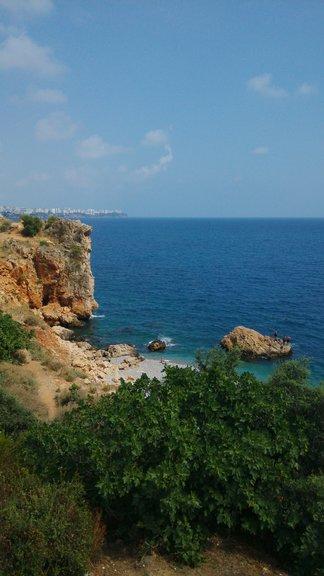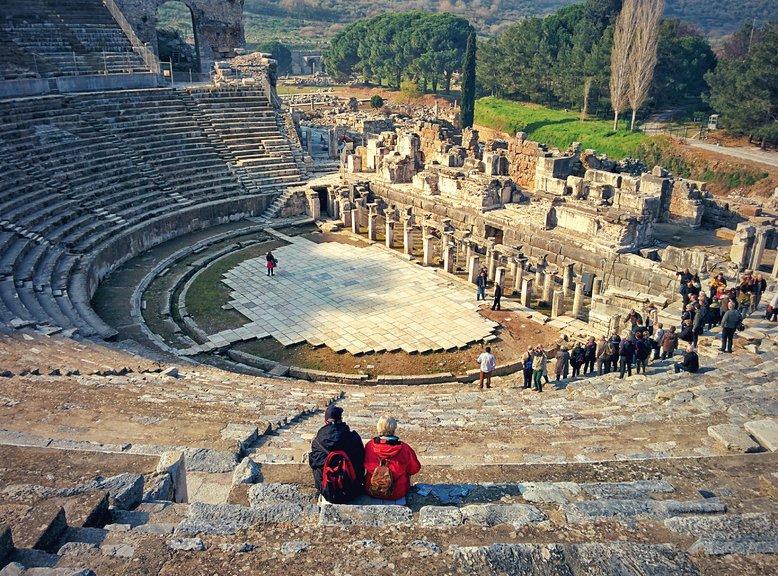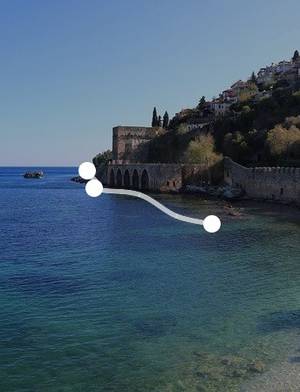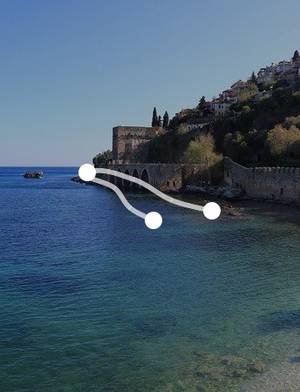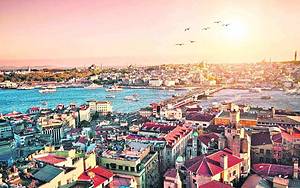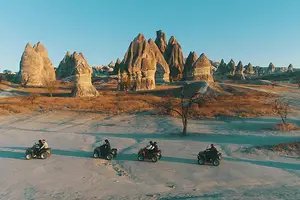7-day tour along the Mediterranean coast of Turkey
7 cities |
27 attraction(s) |
total distance 185
km
 TIPS
TIPS
Day1
Day2
Day3
Day4
Day5
Day6
Day7
Day1: Antalya
6 attraction(s) ·
38 km
1
Antalya Beach, located in the city of Antalya, is different from other beaches in that it is not sandy but covered in small pebbles. It attracts relatively fewer tourists compared to other beaches, so it is rarely crowded. The visitors here are usually local families, making it a great destination for families, friends, or couples on vacation. Antalya Beach is known for its convenient transportation, crystal-clear waters, and it is an excellent place to relax and experience the local way of life during your journey.
2
km
2
The collection is very rich, located 2 kilometers west of the city center. It includes small handicrafts, small sculptures, ranging from the Stone Age to the Bronze Age, and even the Mycenaean civilization, Classical period, and Greek period, making it a journey through time.
4
km
3
The Hadrian's Gate is a marble monument, built during the rule of the Roman Emperor Hadrian (117-138 AD). Many family-run guesthouses in the old city area use this ancient city gate as a starting point landmark because it is easy to find. The three arches are elaborately carved, and the stone columns are beautiful. Some parts of the ancient city walls still remain nearby.
4
km
4
Walking in the historic district of Kaleici, you will find an area untouched by modern development. Many grand Ottoman buildings have been restored and transformed into hotels and guesthouses. The northern part of the district is the most suitable for travelers, with peaceful alleyways.
11
km
5
The waterfall cascades from a 50-meter high cliff and flows into the Mediterranean Sea. The best way to admire this scenery is from the sea, and you can take a boat tour from the old pier in Antalya, which takes about 2 hours.
19
km
6
The ruins of Perge, also known as Perga, are located 18 kilometers from Antalya. It was a settlement of the Hittite people in eastern Anatolia and northern Syria around 1500 BC. The site contains ancient markets, a large bathhouse, and an amphitheater. The most well-preserved structure is the Aspendos ancient theater, renowned for its acoustics. The stage of the theater is intricately carved out of marble, and the sports arena displays sculptures gathered from various corners of the city. Other ruins include a beautifully designed city gate, a long colonnaded street, a public bath, and a gymnasium.
Day2: Antalya
2 attraction(s) ·
39 km
1
Aspendos Theater is located in Antalya and was built in 155 AD. It has a seating capacity of 7,000 people on its stone steps. It is one of the most well-preserved ancient Roman theater ruins in the world. Aspendos Theater is still in use today and hosts the Antalya Opera and Ballet Festival and Arts Festival every summer, without the use of any amplification equipment. The audience enjoys perfect acoustics while sitting on the stone steps that are over two thousand years old.
39
km
2
The riverside of the Kopru River is shaded by green trees, making it a great place for boating and camping. The Kopru River flows through the villages of Bolasan and Beskonak, forming a canyon between them. The canyon has towering cliffs that reach up to 100 meters in height and stretches for 14 kilometers, making it the longest canyon in Turkey. Pine, cypress, and cedar trees are the main plants in the area, and the 400-hectare Mediterranean cypress forest is the largest botanical area in the park. Hunting activities have led to a decrease in the number of wild animals, but the most common animals found here now include deer, goats, bears, foxes, wolves, rabbits, and badgers. The various tributaries of the Kopru River are home to many trout. In addition to the enchanting natural beauty, the famous ancient Roman city of Selge is located 12 kilometers away.
Day3: Kas
3 attraction(s) ·
74 km
1
A small village, located half an hour's drive from Kas, sank into the Mediterranean Sea thousands of years ago due to an earthquake. It is situated southwest of Antalya Province, Turkey, off the Akar Cape coast, at coordinates 36°11′0″N 29°53′0″E, covering an area of 4.5 square kilometers. Originally occupied by Italy, it was returned to Turkey in 1932 through the Italo-Turkish Agreement.
53
km
2
The bay is located below the D400 highway, about 20 kilometers west of Kash Town. Parking is available on both sides of the road. Looking from the road, the sea is clear and the sky is blue. This small bay in the corner of the Mediterranean is beautifully surreal. Descending from the edge of the road along the long stone steps to the beach, you can feel the unique sensation of transitioning from large pebbles to fine sand under your feet. The sea water is clear and the waves are clean. The underwater slope is steep, allowing clear visibility of the transition in water color from pure white to pale green to azure blue. This place preserves the pristine natural landscape, with no fixed food vendors, only a small vendor renting a limited number of beach chairs and sun umbrellas.
21
km
3
The Antiphellos Ruins in Lycia include memorial tombs, the high-placed Lycian sarcophagi, and a well-preserved theater next to the central square.
Day4: Fethiye
4 attraction(s) ·
19 km
1
Speaking of the Dead Sea, people often think of the one next to Israel where you can float on the surface. But that Dead Sea is not the one people commonly refer to. In fact, Turkey also has a Dead Sea called Oludeniz. In the southern part of Turkey, there is a long and winding coastline. Near the ancient town of Fethiye, the coastline meanders into a large bay. It is calm, peaceful, and often referred to as Turkey's "Dead Sea." The beach has soft sand that allows you to enjoy the Mediterranean coast. There are changing rooms, showers, and an open-air bar. Here, you can paraglide from a 3-kilometer-high mountain and admire the beautiful Dead Sea below.
10
km
2
Formerly a village inhabited by Greeks, it was abandoned after a Greek-Turkish agreement in the early 20th century resulted in the exchange of Greeks back to Greece. Located among the mountains, the village's wooden roofs are destroyed, only stone walls remain. The main attraction is the church, which still has preserved murals. Transportation is available by taking a public bus from the bus station, where you pay on board.
8
km
3
The Tomb of Amytas is an Ionian temple built in 350 BC, entirely carved out of rock. The best time to admire it is in the summer twilight. The front of the tomb is entirely carved out of rock, which is very spectacular. Standing here, you can see the panoramic view of Fethiye.
2
km
4
The Stone Sarcophagi of Lycia were built around 450 BC and the entire town was essentially constructed around them.
Day5: Pamukkale
4 attraction(s) ·
7 km
2
Due to the continuous emergence of underground hot spring water, which contains abundant minerals, the formation of Cotton Castle is the result of the spring water flowing out from rocks 200 meters above the plain, undergoing thousands of years of calcification and sedimentation, forming layers of semi-circular white terraces. From a distance, they resemble large cotton flowers standing on the hills. The Turkish people call it "Pamukkale," which means "Cotton Palace," hence the name Cotton Castle. The hot spring water forms natural pools of various sizes, cascading down in layers, sparkling with numerous ripples, creating a unique and extraordinary scenery.
6
km
3
Hierapolis is an ancient Greek city located at the top of a thermal spring, near Denizli in southwestern Turkey. Hierapolis and the nearby site of Pamukkale are UNESCO World Heritage Sites. The thermal springs here have been used for healing since the 2nd century BC, and many people came here to treat their ailments, with some retiring or dying here. The vast necropolis is filled with sarcophagi, including the sarcophagus of Marcus Aurelius. The water wheels are also a sight to see. The grand bath complex was constructed using massive stone blocks without the use of cement, with various open or enclosed sections connected together. The interior of the baths features deep recesses that served as libraries, gyms, and other enclosed or open spaces. This complex was built in the 2nd century BC and represents an exemplary model of vaulted architecture. The complex now serves as an archaeological museum.
1
km
4
The museum next to the ancient city of Hierapolis is located in a primitive Roman bathhouse and is divided into three separate exhibition areas. One displays fascinating sarcophagi, another showcases small artifacts discovered in Hierapolis and nearby Afrodisias, and the third exhibits carved friezes and Roman statues. Notably, the statues of Attis, the lover of the goddess Cybele, and the priestess of the Egyptian goddess Isis are exquisitely beautiful.
Day6: Selcuk > Ephesus
5 attraction(s) ·
7 km
2
In the early AD, St. John came here and wrote the life and teachings of Jesus into "The Gospel of John". Later, he was also buried here. Therefore, in the 6th century, the Byzantine Emperor Justinian built this magnificent church, known as the Basilica of Saint John, on the tomb of St. John. Thus, it became a holy site for Christianity.
1
km
3
The Temple of Artemis is one of the Seven Wonders of the Ancient World. At first, this temple was even more magnificent than the Parthenon in Athens, with 127 columns, each of which was carved with patterns at the base. Unfortunately, in 356 BC, the temple was burned down by Herostratus. Today, only one column remains, which is a great loss.
4
km
4
The Ephesus Theatre was renovated by the Romans between 41 AD and 117 AD. It had a seating capacity of 25,000 people, and each row of seats was designed to be steeper than the previous one, improving the visual and auditory experience for the upper outer audience.
3
km
5
Located 2.5km west of Sirkjuk, the complete ancient city ruins are amazing and a great place to experience and feel the life of the Roman era.
Day7: Izmir
3 attraction(s) ·
4 km
1
Küçük Kordon Square is located by the Aegean Sea and is an important central square in Izmir. The central Küçük Kordon Clock Tower on the square was built in 1901 and is a significant landmark of the city. Other buildings surrounding the square include the Izmir Municipality and Küçük Kordon Mosque.
1
km
2
Kizlaragasi Hani Bazaar is a historical market, originally built as an Ottoman Turkish inn in 1744. It is one of the few remaining Ottoman buildings that combines a courtyard and market. Historically serving as a hotel for Silk Road traders, it is now a bustling market. The bazaar offers a wide range of Turkish specialty goods, from carpets and silver jewelry to woolen scarves and handmade ornaments. The ancient courtyard is also a great place for visitors to enjoy tea and rest.
3
km
3
The Archaeological Museum of Izmir houses a selection of Greek and Roman artifacts, including elaborately decorated sarcophagi, a large head of the Roman emperor Domitian, and impressive friezes. The museum exhibits include archaeological artworks from ancient cities such as Iasos, Çandarlı (Pitane), Bergama, and Bayraklı (Former İzmir). There are also ceramic objects made from burnt clay discovered in the archaeological excavations of the prehistoric city of Iasos dating back to 3000 BC, as well as Anatolian pottery from the Protogeometric and Geometric periods, Anatolian vases with black-red figure designs from the Archaic period, Hellenistic water jugs, and various containers, glass vases, bottles, masks, sculptures, and statues of the goddess Aphrodite from Myrina (Aliağa).
